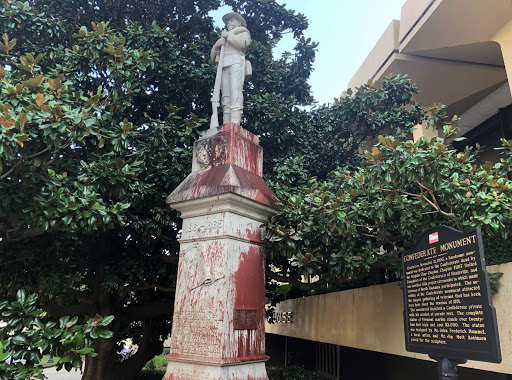In this tumultuous period, questions of historical monuments spark considerable debate among the population, urging matters of how the removal of certain statues should be handled. Although most call for the destruction of monuments venerating white supremacy and the oppression of minorities, there may be more that could be learned from the relocation of particular objects than from outright destruction. Historical interpretation is essential to represent when learning about the past – what better objects to understand historical interpretation than a monument?

Since the George Floyd riots began earlier this year, the Confederate soldier statue residing outside of the Madison County Courthouse in Huntsville, Alabama, has been vandalized with blood-colored paint. Although there have been claims that it will be moved to Maple Hill Cemetery, the Memorial Preservation Act has left it standing in the center of town. Moving this monument to the cemetery does relatively remove it from the public eye; however, a more poignant statement is made in the lack of cleaning attempts that have been made since is defacement. If the statue were to be removed in its present condition, it becomes an even more versatile object for special collections. Both the art museum AND historical museums (like the Space and Rocket Center, which often houses temporary exhibitions) could facilitate contextualization of the statue.
As parts of the landscape in many cities, Confederate monuments prove problematic in their promotion of white supremacist narratives of the Civil War. The destruction of these symbols of oppression is understandable and needed, but the preservation of a few statues could prove to be beneficial in reshaping the effects of the post-Civil War South. Although impossible (and unnecessary) to save EVERY object, historians could work together to identify the most significant ones and preserve them within local archives or even storage spaces of museums. Issues of space at the museums and framing of the artifacts pose the biggest problems of this approach toward relocating the monuments, but this could be an important step for future historians eager for primary sources on the erection of Civil War monuments during the late 19th and early 20th centuries. While controversy is possible and probable when considering saving these artifacts, some of the heat could be diverted by leaving the pieces in storage or creating temporary exhibits using the monuments (or parts of the statues, since they are rather large) as centerpieces for a larger, contextualizing story.
You’ve certainly keyed in on a really key part of contextualization: the space to actually do it! What do you think these should be used to interpret? The Civil War? Jim Crow?